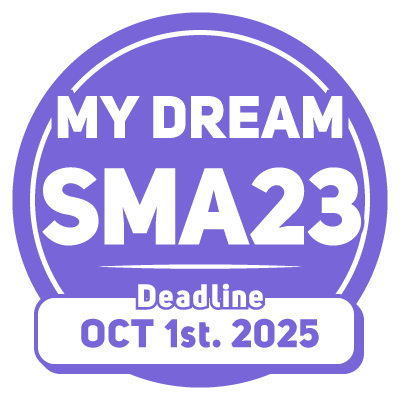



“They say the devil is in the detail. In manga, the more attention you pay to the details, the more life your characters will have. It is this philosophy that has made Japan’s manga culture beloved throughout the world. I look forward to fighting alongside the authors of the world.”
Tokyo, August 2013
“It’s okay to fail as long as… ”
A global manga legend, Tetsuo Hara has produced some of manga’s most iconic titles to date, including ‘Fist of the North Star’, ‘Hana no Keiji’ and ‘Ikusa no Ko’ (Child of War: Legend of Oda Saburo Nobunaga). As a SILENT MANGA AUDITION® Judge, the tireless manga creator spared a few moments to dispense some invaluable advice…
SMAC!: For SMA2, we received 609 works from 65 different countries. A big increase from the first round!
That’s really an amazing number! Even during the “golden age” of ‘Weekly Shonen Jump’, we only got around 100 – 200 entries[1]. Of course I was impressed by the amount, but I was also impressed at the level of drawling skill! The work was of a very high standard.
I could really feel the passion. My first impression was “Wow, there are a lot of talented people in the world”. The artists all came from different cultures and religious backgrounds, but at the end of the day I instinctively felt what they were thinking and what they were trying to say.
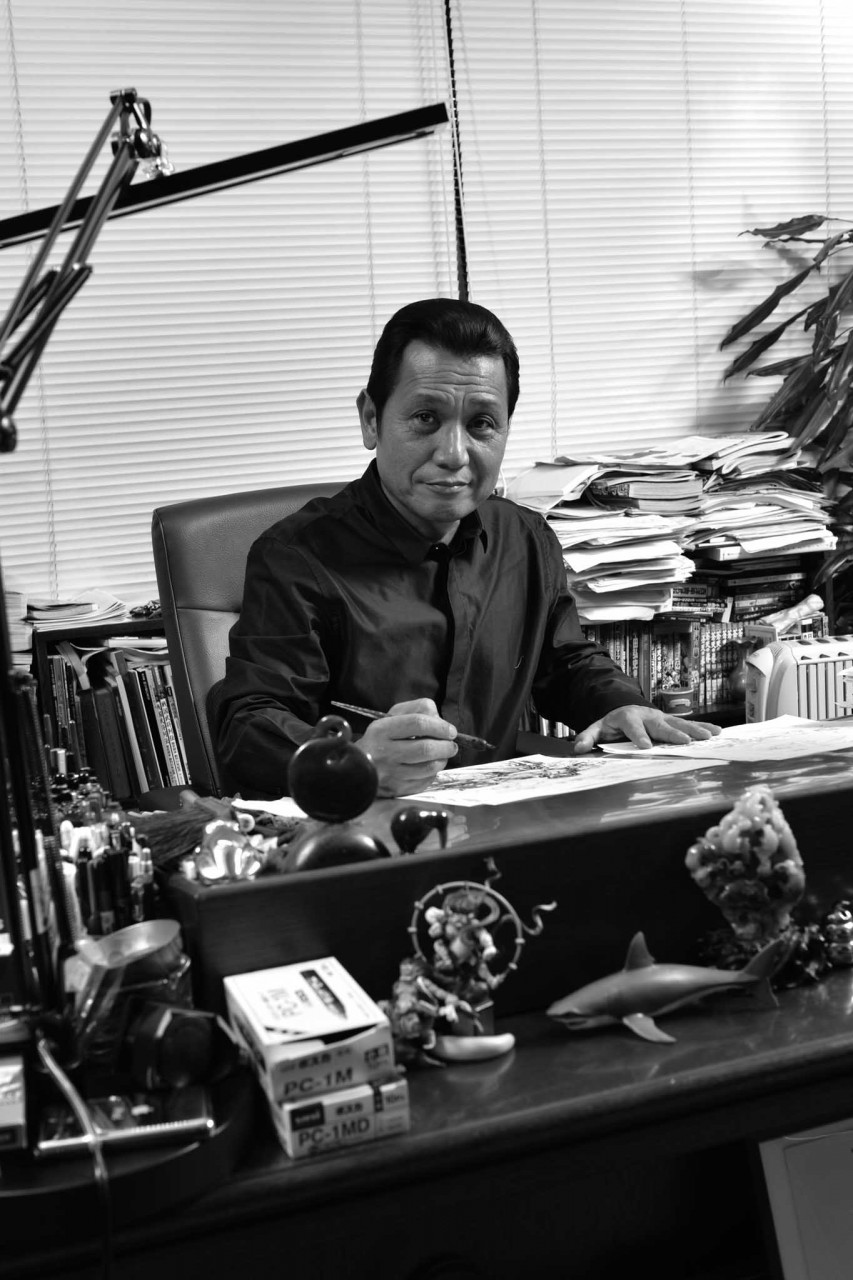
Hara sensei in his studio
SMAC! What is different about the SMA from Japanese manga competitions?
There were lots of entries with beautiful panel layouts. Layouts that we don’t really see in Japanese manga. Without the dialogue, the entire page becomes a picture in itself, and that is what I found most stimulating. They were much freer in the way they created their panels, using all sorts of different sizes and shapes, maybe I could try out some myself! Without speech bubbles getting in the way of the art, there’s a lot more freedom in how you can draw a scene. There’s really an infinite number of ways you can set things up. It made me realize that manga’s charm lies in its panel layout.
SMAC! What do you think about the “silent” part?
With regard to the “silent” part, at first I thought it was going to be very difficult as even at the best of times, manga is limited in a lot of ways. There’s no sound and no color. So we use onomatopoeic words drawn to represent sounds to make the reader feel like they’re hearing something.
We try our best to create a movie-like atmosphere. So taking those words away was a bold move. We lose an important tool, but when you think about our goal to share manga with the people of the world, then language barriers are our biggest obstacle… considering the amount of entries, I think we overcame it.
SMAC! If there was a Silent Manga award when you were younger, would you have entered?
Yeah, I probably would have entered. I’m not particularly good with words or creating storylines. I’m definitely the type who expresses things with pictures, so if someone told me that there was a competition where you didn’t need words, where you could just battle it out with pictures alone, I would have happily drawn something for it!
No matter what country you’re from, if you can draw, you can enter. So the hurdle for entering this competition is set pretty low and I think that’s a good thing – just look at how many entries we collected. And actually, the artists who can express things with pictures alone are the ones who’ll be able to tap into the original power of manga. If you rely too much on words, your pictures stop moving. It happens a lot. So I think this award will help them find their way in the future.
The guys on the publishing side are primarily looking for people who can draw. You can add the words and make up the story later. In Japan, we have editors to help us with that. We make our manga as a team. So if there are people all over the world who can draw, we just need to send editors and then they’ll be able to get even better, expanding possibilities in what they can create. And then manga will spread even further. If we have people drawing manga in every country and the industry becomes successful, then lots of people will be able to make a living doing what they love.
SMAC! Let’s talk about the theme for SMA2… ‘The Finest Smile’.
Compared with the SMA1 theme (Love Letter), this round was a little more difficult. I think that the young artists had a bit of hard time with this one. When you’re young, you’re a bit nihilistic and you want everything to be cool.
Of course, not everyone is this way, but when I was young, I rebelled against a world the older generation had created. I couldn’t draw smiles and I didn’t want to draw smiles! In my later years when I drew ‘Hana no Keiji’[2], my editor told me over and over to re-draw the smiles. But thanks to that, I became good at drawing smiles and I was able to grow a little. I think smiles are really important in the world today.
So it might make the difference as to whether you’ll be able to make it big or not. To be a great artist, you need to be able to perfectly draw all of your character’s emotional states.
SMAC! What did you think about the grand prize winner, ‘Father’s Gift’?
The scene illustrates the girl’s emotions really strongly (Click to open Embedded Viewer)
It was really very good. The pictures were great and the scene where the girl was crying was amazingly easy to empathize with. Your body twists into strange positions when you cry… so I could really feel the emotion. But looking back at it again, although the composition was very good, I thought that the robot’s smile was a little scary. I mean, not the smile as such, more the panel layout. It felt like the kind of panel layout you would use for a horror or suspense film.
The theme was ‘The Finest Smile’, but the tone felt a little bit like a horror. Of course, if that’s what the author was going for, then it’s okay. There’s no life behind a robot’s eyes, so perhaps it would have been creepy no matter what he did. But it’s times like this when it really helps if you can get an impartial opinion about your work. Even professionals fall into this trap. If you don’t get lots of feedback for your work, it ends up becoming more and more eccentric. This happened to me before my editor beat it out of me and made me start over! If there’s someone close to you who can give you an impartial opinion, your work will become more relatable and you’ll improve as an artist.
What do you think is in the robot’s eyes? Different cultures may draw different conclusions. (Click to open Embedded Viewer)
SMAC! Were there any other works that left an impression on you?
The scene is drawn, with cinematic techniques and expression(Click to open Embedded Viewer)
I liked the work ‘Forward’. The pictures were great but there were some on the judging panel that felt that it was difficult to understand. I think it’s fine if you interpret it as you please. It was very movie-like. It was drawn like a video and it also had that feeling.
There was also a certain femininity to it. For this artist, instead of giving advice, I want to tell her to just keep growing. The piece had good sense so it’s not really necessary for me to say anything. It’s okay if you don’t understand it. In fact, it’s good if you don’t understand it. I felt some pure talent there. So I hope she’ll keep on drawing.
SMAC! What methods are necessary for an artist to improve?
What I can say, and I think this applies to everyone who entered, is that it’s going to be difficult to sell your manga as a product. Of course, the quality is there and each of you have your own unique style and strengths. But sometimes, this can actually be a bad thing.
So, you have to show your work to people. In a business sense as well, you need to do this to move up to the next level. It’s important to show your work to your editor, along with lots of other people and listen to their opinions. If you do that, I think your manga will get better and better.
Before I got my own editor, I used to draw doujinshi (self-published works) and I’d often show my work to other artists. Or I’d draw 4 panel manga in class and show it to my friends. I’d also enter manga awards.
At that time, Shotaro Ishinomori-sensei[3] was running a manga school and it was there that I learned, that to understand composition, I should draw lots of 4 panel manga. They suggested “a manga a day”… in other words, that we should try to make a 4 panel manga every day. I tried to do that, and worked at it every day.
I’d enter those into competitions, sometimes I’d win and sometimes I’d lose and through that, I was continually learning about what works and what doesn’t. Other people’s opinions are really good for us. Of course, we don’t like to be criticized, but I think it’s really important. Because what artists really want, is for our pictures to make other people happy.
SMAC! So you really need someone like an editor?
It’s because I met my editor, Mr. Horie that I was able to become a professional manga artist. I’d draw storyboards, have him review them and then correct them based on what he told me. I’m really glad that editors are there to help us.
In Japan, we have the creator/editor system in place to help us make manga, but artists in other countries don’t! So they have to work alone. I know everyone loves drawing, but I think that on a fundamental level, they’re not sure what they should draw. Everyone wants to draw an amazing manga, but you’re not always sure where to start. Even if you’re good at art, you might not be so good in other areas. Unless you’re really a genius, you can’t manage everything by yourself.
SMAC! What is the difference between Japanese manga and overseas comics?
For example, American comics have really fast pacing. There’s one action scene after another, leaving no “space” between panels, leaving no time for the reader to think. Because they have to squeeze so much story in so few pages, they couldn’t have any unnecessary scenes in-between the action. In this way, they became a bit like illustrated books, and the panel layouts reflect this.
Of course, among comic book artists, there are really talented guys like Neal Adams [5], who can draw amazing, expressive pictures. But I think at the end of the day, the panel layout is completely different. The dialogue doesn’t have that much feeling, it’s more like explanatory text. So it feels sort of inorganic and the emotions don’t really get across.
In the case of Japanese manga, we’re trying to draw the character’s mental state, so we’ll take a few extra panels and the story ends up being longer. For a weekly episode, we draw about 20 pages a week. In America, one monthly issue is only about 15 pages, right? I think that’s a big difference. But on the other hand, there’s a lot more detail crammed into each picture over there. France’s bande dessinées[6] is also like that. So you could say it’s closer to a picture book. I think that it’s because we try to express emotions when it becomes more movie-like, with the unique “flow” in storytelling. In this way, the “grammar of manga” has definitely been passed along.
People who love Japanese manga are drawing manga so it’s completely different from American comics. Of course, I’m sure they’re influenced by their local comics but the influence of Japanese manga is also really big. I can tell just by looking at their panel layouts. So they’re kind of hybrid artists. And I really feel that Tezuka-sensei’s methods have spread all over the world.
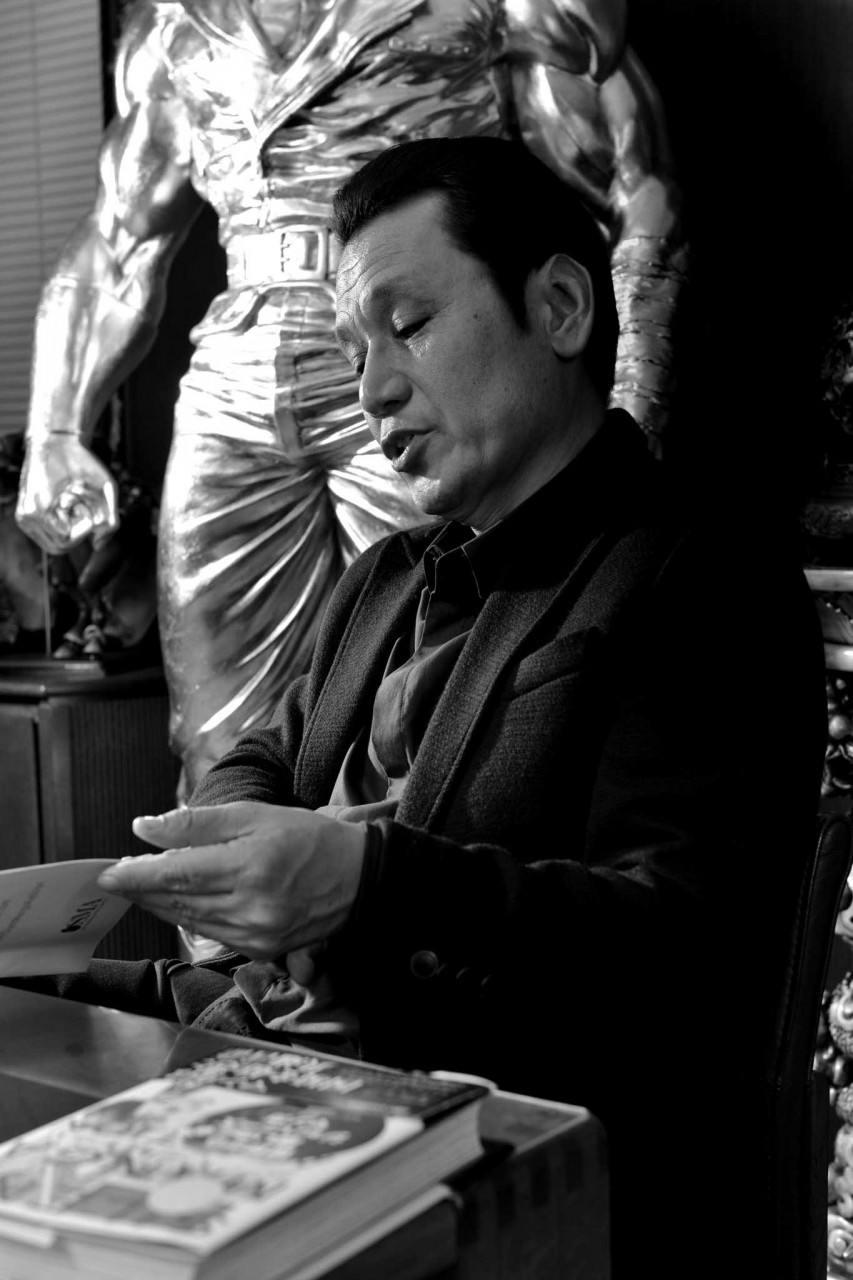
SMAC! Is the way people think of manga different in other countries?
In America and France, comics are drawn in color and I would have to say it’s looked at as a form of art. If you go to those countries, they’ll say “drawing manga is art”, but we don’t think that way in Japan.. we see manga as entertainment. That way of thinking maybe fundamentally different, but I guess young artists who have entered their works into this competition maybe at half way between these two schools of thought.
They know the entertainment side of manga, and they are in love with it. So to draw in more talent like theirs, I think it’s really important we keep doing this audition. We need to continue this award and continue making manga the universal language.
As for how it will evolve from here… I’m looking forward to the amalgamation of Japanese manga and manga from the rest of the world. I think that this challenge is the first of this kind, of creating manga with talents scattered around the globe. I’m waiting with high hopes, to see the possibilities of new manga that evolved in many different places.
SMAC! As a professional manga artist, what do you consider to be really important?
Well, maybe because more people are reading manga online nowadays, there are too few people who make use of double-page spreads. It’s very important to make the reader want to turn the page. With a double page spread, you firstly have the impact of the overall scene, then the middle point and the final panel. It’s this final panel in the bottom left corner that needs to be the “hook” that makes the reader turn the page.
The panels must flow smoothly enough that the reader wants to know what happens next. In this business, it is absolutely essential to make the reader want to keep on reading. People often use the term “eye-catching”. First you have to get their attention. If they don’t start reading, then it’s all for nothing, right? So they’re flipping through the magazine and suddenly there’s a scene that makes them stop. “What’s going on here?” they think, and their hand stops moving. Then hopefully, they’ll go back to the beginning and read your story. You need to have a scene that catches their eye. A scene that makes them wonder what’s happening.
Which brings this question: “What’s the ‘hook’ that grabs the reader’s attention?” This is the topic you must always have in your mind. So, if you’re aiming to be a professional, you can’t just draw without thinking, using guesswork. You have to think about what you want to show the reader. Once you start thinking about how to draw your reader in, then you’ve taken the next step as an artist. So in that sense… when I look at the entries we’ve received, I think the artists are still drawing from a reader’s perspective.
Being a professional, often means “To be detached from yourself”. I see a similarity here with the way of the samurai. It’s the same kind of attitude in manga. To be a pro, mangaka or samurai, you can’t just do it for yourself. You do it for the sake of other people’s happiness. When I was drawing ‘Fist of the North Star’[7], I kind of lost myself, only to find myself as a living creature on those papers. But it was because I dedicated those moments of my life for the sake of manga, that the readers kindly accepted my work into the very core of their hearts and souls.
SMAC! So your first priority should be thinking about what will make the reader happy?
That’s right. The reader is your number one priority. To make your reader’s enjoyment your first priority, you have to be detached from yourself. Sacrifice yourself…
It’s a question of whether you can do that or not. We’re not talking about one or two stories here, you have to keep drawing story after story. That gradually becomes harder and harder, but you absolutely cannot draw in a way that makes it easy for you. To the readers, if the author doesn’t draw as if his life is on the line… then it’s not worth reading.
Drawing manga isn’t a job that you can just do moderately and then pick up your pay. That’s not what your readers want. Readers are greedy, they always want more from you. So you’ve just got to make it as interesting as possible. It can sometimes be a pretty tough job.
“It’s important to keep on challenging, but you can’t get stuck there forever”
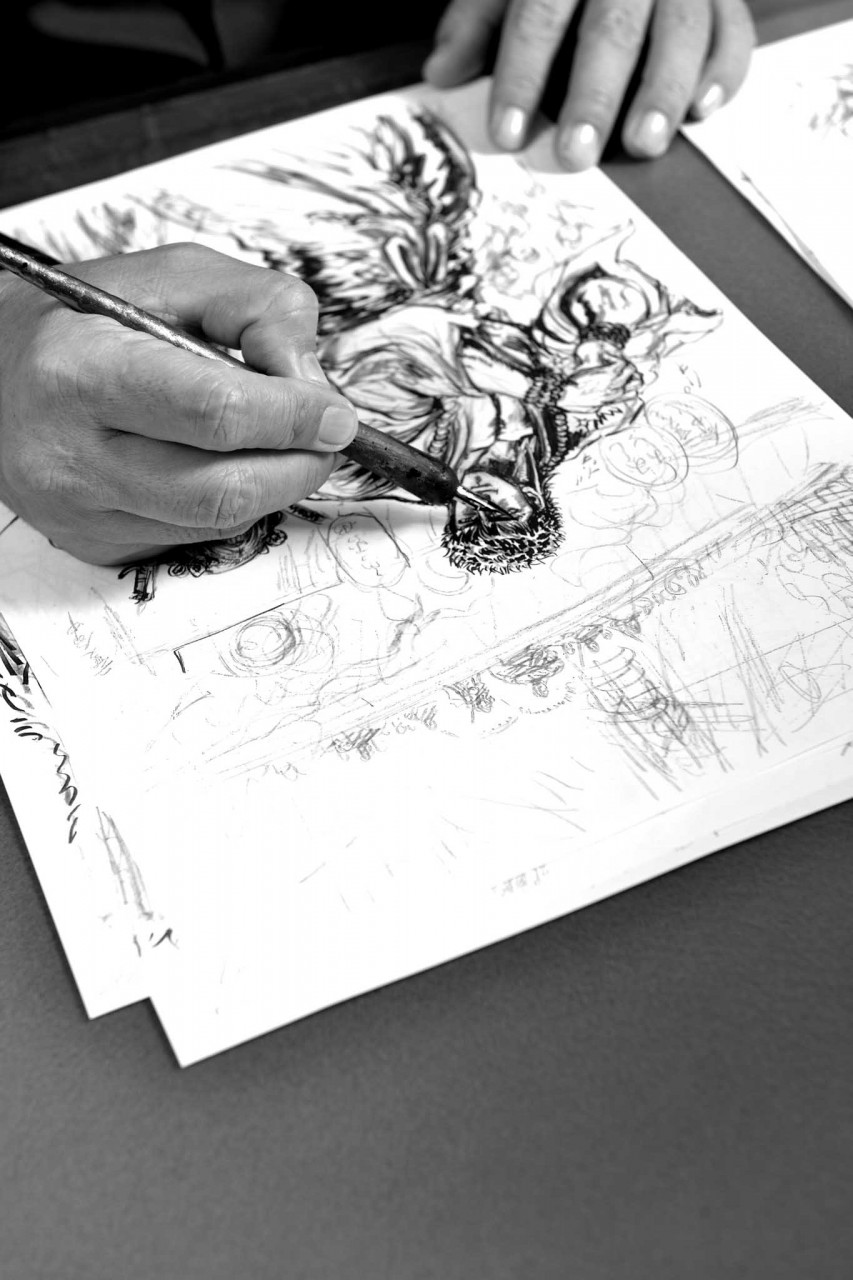
SMAC! What do you do when you get “Writer’s block”?
For example, if you’ve got an image in your head, but you can’t draw it, you need to keep trying, but at the same time, you can’t get stuck there forever. Sometimes you just let it go, and try an angle you can actually draw. It’s okay as long as you do your best. However if you are capable of something, but not doing it… that’s the worst thing that can happen to an artist.
There may be times in your long career as an artist where you just have to get by like that… to save yourself from overwork. But when that happens, when you just take the easy way out, it won’t reach the reader’s soul. It simply becomes a waste of your time and the reader’s time. You won’t become successful by drawing throw-aways. It just won’t sell, at least not in volume. No, you want to draw something that will stand the test of time, something that the readers will keep going back to. That’s what the readers are looking for. And it’s tough for the ones doing the drawing.
So, maybe there are some of you who aren’t giving it 100%. To protect yourself, you tell yourself that you’re just drawing for fun, or that it’s just a hobby. To be a pro, you can’t make excuses like that. You have to change the way you think. There are lots of people who are stubborn and say “This isn’t necessary” or “I don’t need to go that far”. I for one, was awfully stubborn! But once I tried drawing for other people, it was much more interesting in different ways.
By detaching yourself from a mere reader’s point of view, you will discover a completely new form of satisfaction, a sense of progress, and you’ll also see your happiness multiplied through the readers. Once you find all that, and when you successfully complete a good piece of work, the sensation of happiness you feel is that much greater, multiplied by the readers, editors and yourself, all working in unison.
SMAC! Lastly, as a representative of the judging panel 2014, could you say a few words to the artists all over the world?
“Draw the things you love”, but at the same time “draw to please others”. Keep both objectives in focus throughout your journey as an artist. Try to revolutionize yourself with that in mind, and always have fun drawing.
“The more you throw yourself into your work, the more the world opens up to you.”
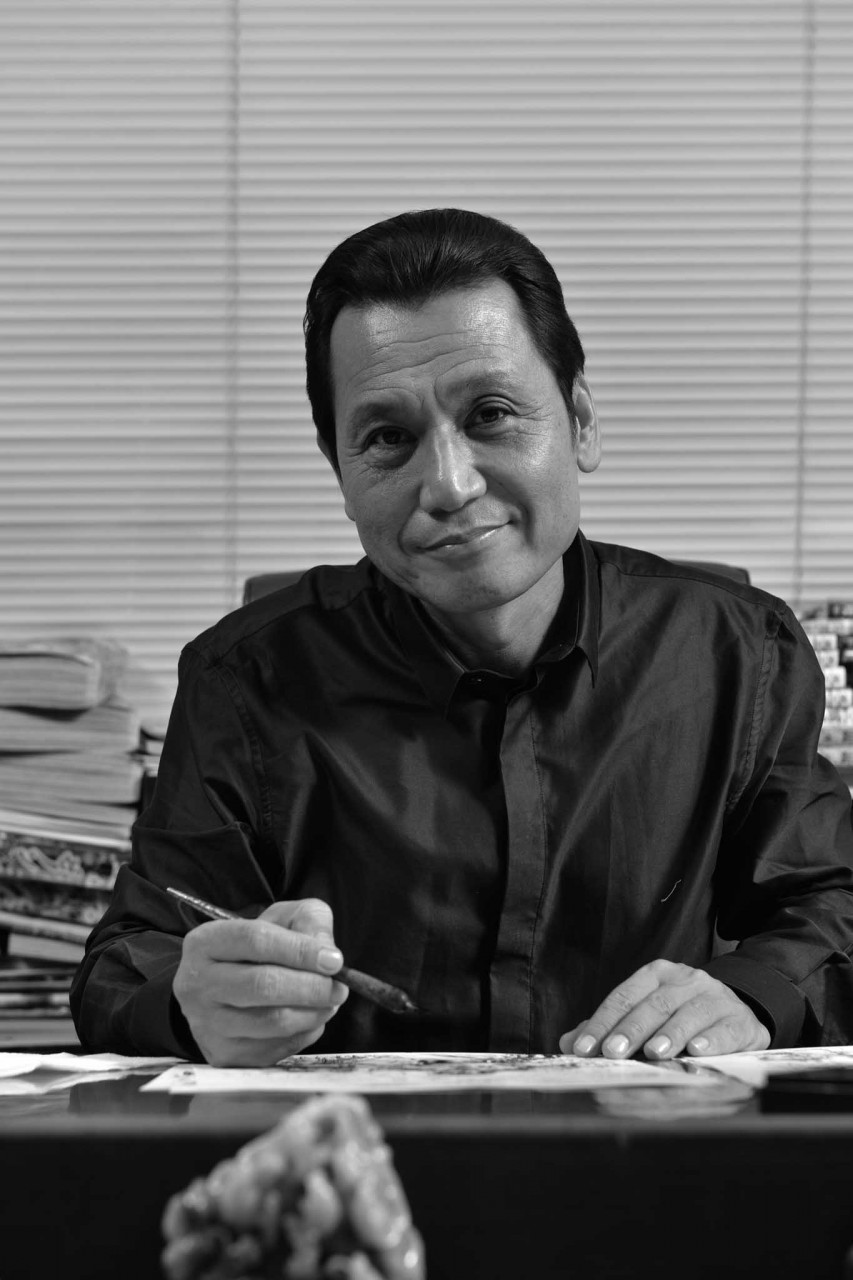
[1] Weekly Shonen Jump
A weekly manga magazine by Shueisha. At the height of its success, it sold over 6.5 million copies, earning a place in the Guinness World Records.
[2] Hana no Keiji
A manga by Tetsuo Hara based on Keiichiro Ryu’s novel ‘Ichimuan Furyuki’, where he tried to capture Keiji Maeda’s wild, uninhibited life.
[3] Shotaro Ishinomori
A manga artist known as “The King of Manga”. His notable works include ‘Cyborg 009’, ‘An Introduction to Japanese Economics, the Manga’ and ‘Hotel’. He was also the creator of the ‘Kamen Rider’ series.
[4] Nobuhiko Horie
The editor in charge of Tetsuo Hara since his debut as a manga artist. Currently the president of Coamix, he is also a scriptwriter for anime and manga.
[5] Neal Adams
An American comic artist who drew ‘Batman’ in the 70s, starting a revolution in the comic book industry.
[6] Bande dessinées
Artistic story comics, read mainly in the French speaking world. With beautiful, full color illustrations, there value as art is very high.
[7] Fist of the North Star
Written by Buronson, illustrated by Tetsuo Hara. Set at the end of the 20th century, when civilization has been devastated by nuclear war and all order has been lost. The story is about the life and battles of the successor to the Fist of the North Star assassination, Kenshiro.
A Tokyo native, born in the capital’s famous Shibuya district, Tetsuo Hara was an avid manga reader who spent much of his childhood with classics such as ‘Tensai Bakabon’, and ‘Tiger Mask’.
Heavily inspired by the enjoyment theses titles gave him, Hara soon decided that he too wanted to become a professional manga creator, and immediately set to work by joining the very same high school manga club that Osamu Akimoto (‘KochiKame’) was a member of some years earlier.
Determined to pursue the path of a manga creator, Hara dropped out of university mid-term and began submitting works to ‘Weekly Shonen Jump’, even attempting to work under Osamu Akimoto as an assistant. Despite his best intentions however, Hara’s hopes of working under his peer were dashed when he got lost en route and couldn’t find his house!
Not one to give up easily, Hara’s persistence finally paid off when applying to become an assistant to Buichi Terasawa of ‘Space Adventure Cobra’ fame. Terasawa’s editor at the time, Nobuhiko Horie took a liking to Hara’s work and personally introduced him to Yoshihiro Takahashi, creator of ‘Silver Fang: The Shooting Star Gin’. Finally finding a home to improve his manga creating skills, Hara put his talents to the test and entered Shueisha’s 33rd Fresh Jump Award, securing the top prize with his boxing one-shot ‘Super Challenger’.
His publishing debut turned a lot of heads and before long, his second boxing one-shot, ‘Mad Fighter’, was published in ‘Fresh Jump’ magazine. Impressed by Hara’s potential, Horie invited him to try his hand at motocross, offering him his first ever serialization within the pages of ‘Weekly Shonen Jump’. Despite motocross being a hot topic among the public at the time however, ‘Iron Don Quixote’ failed to enamor readers, being dropped from serialization after only a few weeks. Though at first a shock to all involved, it proved to be a crucial turning point in Hara’s career when he bounced back with the immensely successful ‘Fist of the North Star’.
Spanning 27 volumes, 152 animated episodes, several spin-off movies and video games, ‘Fist of the North Star’ became a global phenomenon. Though the serialization ended in 1988, Hara’s passion for manga creation never waned as he continued to present readers with titles such as ‘Hana no Keiji’(Keiji), ‘Cyber Blue’, ‘Takeki Ryūsei’, and ‘Sakon’.
Prolific as his output was, Hara broadened his scope in 2000 by teaming up with his fellow creators, Tsukasa Hojo, Ryuji Tsugihara, and longtime editor, Nobuhiko Horie to form COAMIX Inc. . With a new publishing entity established, Hara hit the ground running by returning to the franchise that put him on the map, creating ‘Fist of the Blue Sky’, a direct prequel to ‘Fist of the North Star’. The new serialization proved a hit among North Star fans and later received its own anime adaptation and sequel in the form of currently running serialization ‘Fist of the Blue Sky: Regenesis’.
Hara’s passion for manga remains as strong as ever with a handful of different works gracing the pages of ‘Monthly Comic Zenon’ each month, in addition to being a member of the judges panel in the SILENT MANGA AUDITION® Committee.